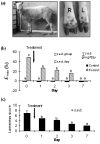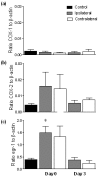Co-induction of cyclooxygenase-2 [correction of cyclooxyenase-2] and early growth response gene (Egr-1) in spinal cord in a clinical model of persistent inflammation and hyperalgesia
- PMID: 22112635
- PMCID: PMC3256114
- DOI: 10.1186/1744-8069-7-91
Co-induction of cyclooxygenase-2 [correction of cyclooxyenase-2] and early growth response gene (Egr-1) in spinal cord in a clinical model of persistent inflammation and hyperalgesia
Abstract
Background: This study characterised the effects of persistent peripheral inflammation of the foot on pain and spinal cord expression of cyclooxygenase-1 and -2 (COX-1 and COX-2) and early growth response gene 1 (Egr-1), known markers of neuronal plasticity, in a clinical model of naturally-occurring inflammatory disease and hyperalgesia in sheep ('footrot'), before and after routine treatment (parenteral treatment with antibiotics and antiseptic footbathing). The temporal pattern of expression of COX-1, COX-2 and Egr-1 mRNA and protein were analysed using real-time PCR and Western blotting.
Results: Animals affected with persistent peripheral inflammation displayed significant hyperalgesia and lameness (a proxy indicator of spontaneous pain) restricted to the inflamed limb. Hyperalgesia and lameness were significantly attenuated 1 day after treatment, and resolved further by day 7 and day 3, respectively. COX-2 but not COX-1, protein expression was up-regulated in spinal cord from lame animals on day 0, before treatment. Following treatment and attenuation of pain behaviours, levels of COX-2 returned to control levels. Significant induction of Egr-1 mRNA and protein were observed in spinal cord from lame animals. Three days after treatment, levels of Egr-1 mRNA returned to control levels, however, Egr-1 protein remained elevated.
Conclusion: Elevated levels of spinal COX-2 and Egr-1 protein correlate with the presence of pain and hyperalgesia, and may underlie persistent pain, although a direct causal link has still to be established. Understanding the temporal pattern of expression of key mediators in clinical pain states may lead to better strategies to manage pain.
Figures




Similar articles
-
Up-regulation of metabotropic glutamate receptor subtypes 3 and 5 in spinal cord in a clinical model of persistent inflammation and hyperalgesia.Pain. 2003 Dec;106(3):501-512. doi: 10.1016/j.pain.2003.09.017. Pain. 2003. PMID: 14659534
-
Role of interleukin-1beta and tumor necrosis factor-alpha-dependent expression of cyclooxygenase-2 mRNA in thermal hyperalgesia induced by chronic inflammation in mice.Neuroscience. 2008 Mar 18;152(2):477-86. doi: 10.1016/j.neuroscience.2007.10.039. Epub 2007 Nov 12. Neuroscience. 2008. PMID: 18262365
-
Transcutaneous electrical nerve stimulation attenuates CFA-induced hyperalgesia and inhibits spinal ERK1/2-COX-2 pathway activation in rats.BMC Complement Altern Med. 2013 Jun 15;13:134. doi: 10.1186/1472-6882-13-134. BMC Complement Altern Med. 2013. PMID: 23768044 Free PMC article.
-
COX-2 expression and function in the hyperalgesic response to paw inflammation in mice.Prostaglandins Leukot Essent Fatty Acids. 2008 Dec;79(6):183-90. doi: 10.1016/j.plefa.2008.08.001. Epub 2008 Oct 1. Prostaglandins Leukot Essent Fatty Acids. 2008. PMID: 18829279 Free PMC article.
-
Prostaglandins and cyclooxygenases [correction of cycloxygenases] in the spinal cord.Prog Neurobiol. 2001 Jul;64(4):327-63. doi: 10.1016/s0301-0082(00)00063-0. Prog Neurobiol. 2001. PMID: 11275357 Review.
Cited by
-
Acute Transcriptomic and Epigenetic Alterations at T12 After Rat T10 Spinal Cord Contusive Injury.Mol Neurobiol. 2023 May;60(5):2937-2953. doi: 10.1007/s12035-023-03250-w. Epub 2023 Feb 8. Mol Neurobiol. 2023. PMID: 36750527
-
Time course of immediate early gene protein expression in the spinal cord following conditioning stimulation of the sciatic nerve in rats.PLoS One. 2015 Apr 10;10(4):e0123604. doi: 10.1371/journal.pone.0123604. eCollection 2015. PLoS One. 2015. PMID: 25860146 Free PMC article.
-
Left-right side-specific endocrine signaling complements neural pathways to mediate acute asymmetric effects of brain injury.Elife. 2021 Aug 10;10:e65247. doi: 10.7554/eLife.65247. Elife. 2021. PMID: 34372969 Free PMC article.
-
Role of CGRP in Neuroimmune Interaction via NF-κB Signaling Genes in Glial Cells of Trigeminal Ganglia.Int J Mol Sci. 2020 Aug 20;21(17):6005. doi: 10.3390/ijms21176005. Int J Mol Sci. 2020. PMID: 32825453 Free PMC article.
-
Integrated Analysis of lncRNA-miRNA-mRNA ceRNA Network in Mixed Dry Eye Disease.Contrast Media Mol Imaging. 2022 May 17;2022:1534142. doi: 10.1155/2022/1534142. eCollection 2022. Contrast Media Mol Imaging. 2022. Retraction in: Contrast Media Mol Imaging. 2023 Jul 26;2023:9830234. doi: 10.1155/2023/9830234. PMID: 35935315 Free PMC article. Retracted.
References
-
- Beveridge WIB. Foot rot in sheep: a transmissible disease due to infection with Fusiformis nodosus (n. sp.): studies on its cause, epidemiology and control. Commonwealth Scientific and Industrial Research Organisation (CSIRO) Australian Bulletin. 1941;140:1–56.
Publication types
MeSH terms
Substances
LinkOut - more resources
Full Text Sources
Research Materials

